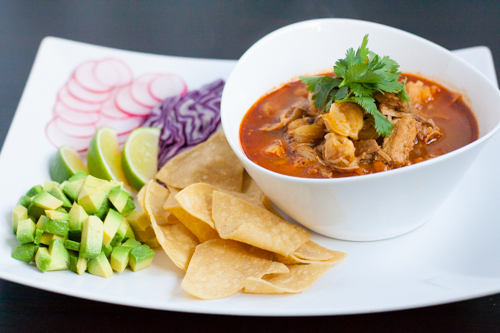Pozole Rojo
 Sunday, December 17, 2017 at 10:26AM
Sunday, December 17, 2017 at 10:26AM 
This recipe first appeared on the Borough Market website as part of a 3 part series I am writing exploring lesser-known religious traditions in December from around the world.
This spicy soup with hominy and slow-cooked pork shoulder is a party favourite in Mexico. It is often served at Las Posadas festivities, celebrated from 16th to 24th December. However, the religious significance of the dish precedes this Christian festival. Corn was a sacred plant for the Aztecs, so they cooked pozole to mark special occasions.
It is a great party main because it is easy to make in large batches (this recipe serves about 8-10 people) and there are lots of garnishes that guests can add to customise their bowl of soup.

Ingredients
For the soup
300g dried hominy, soaked in cold water overnight
1kg pork shoulder
2 medium brown onions
1 knob garlic
1 bunch coriander
2 bay leaves
2L chicken stock or water, approx.
3 dried ancho chillies, stems, pith and seeds removed
3 dried guajillo chilles, stems, pith and seeds removed
2 dried arbol chillies, stems, pith and seeds removed
1 tbsp vegetable oil
2 tsp cumin seeds, toasted and ground
2 tsp dried Mexican oregano
For the garnishes (choose your favourites or go for all of them)
Cabbage or romaine lettuce, finely shredded
Radishes, finely sliced
Limes, quartered
Avocado, diced
Totopos
Coriander leaves
Method
Drain the hominy, rinse and put in large saucepan of cold water. Bring to the boil over a high heat then reduce to a simmer. Don’t add any salt, as it will make the hominy tough. Remove any scum that forms on the top of the water and add more water as required. Cook for approx. 2 hours. Drain and set aside.
Put the pork shoulder in a saucepan with 1 of the onions (peeled and cut in half), half of the garlic cloves (smashed), a handful of coriander and the bay leaves. Pour over enough chicken stock to cover the pork. Cover with a lid and cook over a low heat for 1 hour. Remove from the heat and leave to cool. Drain the stock, reserving the liquid. When cool, shred the meat and set aside.
Boil a small saucepan of water and add the chillies. Simmer over a low heat until rehydrated (approx. 10 minutes). Drain, reserving the soaking liquid.
Add the chillies, cumin, oregano, the rest of the garlic cloves (peeled) and the other onion (peeled and roughly chopped) to a food processor with 1 cup of the chilli soaking liquid. Blend until smooth.
Push the puree through a fine strainer into a bowl, using the back of a spoon to extract as much liquid as possible. Discard the pulp (or save for a marinade).
Heat the oil in a large saucepan over a medium heat. Add the puree and bring to a simmer, stirring occasionally. Add the hominy, pork and remaining stock and soaking liquid. Simmer for an hour or until the pork is very soft and tender. Top up with water as necessary. Season with salt, to taste.
Serve with your chosen garnishes.

Read my article about Las Posadas celebrations in Mexico on my Food Anthropology page or on the Borough Market website.

Reader Comments